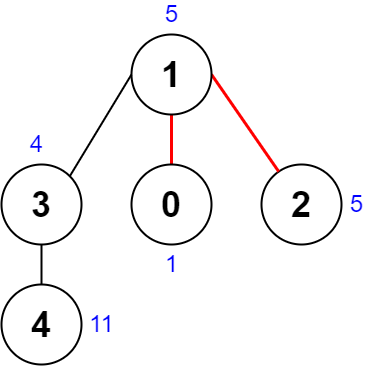2322. Minimum Score After Removals on a Tree


Description
There is an undirected connected tree with n nodes labeled from 0 to n - 1 and n - 1 edges.
You are given a 0-indexed integer array nums of length n where nums[i] represents the value of the ith node. You are also given a 2D integer array edges of length n - 1 where edges[i] = [ai, bi] indicates that there is an edge between nodes ai and bi in the tree.
Remove two distinct edges of the tree to form three connected components. For a pair of removed edges, the following steps are defined:
- Get the XOR of all the values of the nodes for each of the three components respectively.
- The difference between the largest XOR value and the smallest XOR value is the score of the pair.
- For example, say the three components have the node values:
[4,5,7],[1,9], and[3,3,3]. The three XOR values are4 ^ 5 ^ 7 = 6,1 ^ 9 = 8, and3 ^ 3 ^ 3 = 3. The largest XOR value is8and the smallest XOR value is3. The score is then8 - 3 = 5.
Return the minimum score of any possible pair of edge removals on the given tree.
Example 1:

Input: nums = [1,5,5,4,11], edges = [[0,1],[1,2],[1,3],[3,4]] Output: 9 Explanation: The diagram above shows a way to make a pair of removals. - The 1st component has nodes [1,3,4] with values [5,4,11]. Its XOR value is 5 ^ 4 ^ 11 = 10. - The 2nd component has node [0] with value [1]. Its XOR value is 1 = 1. - The 3rd component has node [2] with value [5]. Its XOR value is 5 = 5. The score is the difference between the largest and smallest XOR value which is 10 - 1 = 9. It can be shown that no other pair of removals will obtain a smaller score than 9.
Example 2:

Input: nums = [5,5,2,4,4,2], edges = [[0,1],[1,2],[5,2],[4,3],[1,3]] Output: 0 Explanation: The diagram above shows a way to make a pair of removals. - The 1st component has nodes [3,4] with values [4,4]. Its XOR value is 4 ^ 4 = 0. - The 2nd component has nodes [1,0] with values [5,5]. Its XOR value is 5 ^ 5 = 0. - The 3rd component has nodes [2,5] with values [2,2]. Its XOR value is 2 ^ 2 = 0. The score is the difference between the largest and smallest XOR value which is 0 - 0 = 0. We cannot obtain a smaller score than 0.
Constraints:
n == nums.length3 <= n <= 10001 <= nums[i] <= 108edges.length == n - 1edges[i].length == 20 <= ai, bi < nai != biedgesrepresents a valid tree.
Solution
minimum-score-after-removals-on-a-tree.py
class Solution:
def minimumScore(self, nums: List[int], edges: List[List[int]]) -> int:
N, M = len(nums), len(edges)
graph = defaultdict(list)
children = defaultdict(set)
xor = nums.copy()
V = 0
degree = [0] * N
for a, b in edges:
graph[a].append(b)
graph[b].append(a)
degree[a] += 1
degree[b] += 1
seen = set()
dq = deque()
for node in range(N):
V ^= nums[node]
if degree[node] == 1:
dq.append(node)
seen.add(node)
while dq:
node = dq.popleft()
for nei in graph[node]:
if nei not in seen:
children[nei].add(node)
children[nei] |= children[node]
xor[nei] ^= xor[node]
degree[nei] -= 1
if degree[nei] == 1:
dq.append(nei)
seen.add(nei)
res = float('inf')
for i in range(M - 1):
for j in range(i + 1, M):
a, b = edges[i]
if b in children[a]:
a, b = b, a
c, d = edges[j]
if d in children[c]:
c, d = d, c
if a in children[c]:
curr = [xor[a], xor[c] ^ xor[a], V ^ xor[c]]
elif c in children[a]:
curr = [xor[c], xor[a] ^ xor[c], V ^ xor[a]]
else:
curr = [xor[c], xor[a], V ^ xor[c] ^ xor[a]]
res = min(res, max(curr) - min(curr))
return res